Fifteen cormorants, for about as many years, have hung around some old posts on the other side of the resaca. Another post is in the middle of the resaca a little way from those posts. The single post is directly in line with the window above our kitchen sink. Different birds take turns using it as a lookout.
Our group of cormorants disappear sometime in late fall and return in December. Currently there are new flashes of white on the snags at the far bank. I grab my binoculars and look for the some-time visitor — the anhinga. But no, the white isn’t right. It’s a juvenile cormorant.
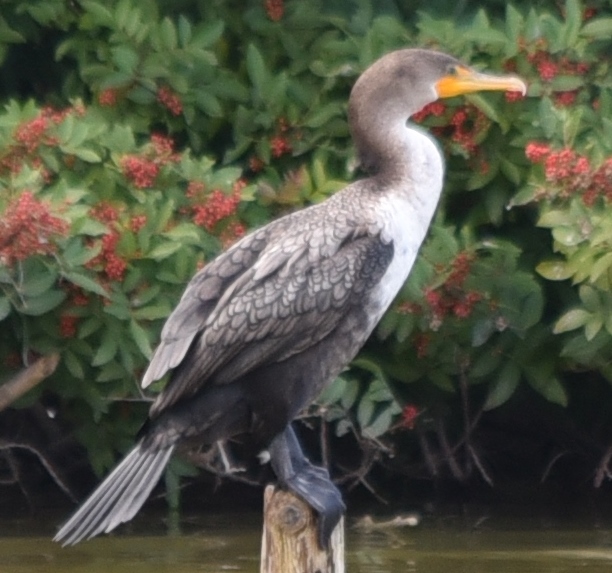
With photos enlarged on my computer screen, I can study details and reference my birding book and Internet bird information. An anhinga can easily be mistaken for a cormorant from a distance. A quick way to tell which bird you’re seeing is to look at the bird’s bill through binoculars.
An anhinga has a straight, long, thin, pointed bill — they spear their prey.
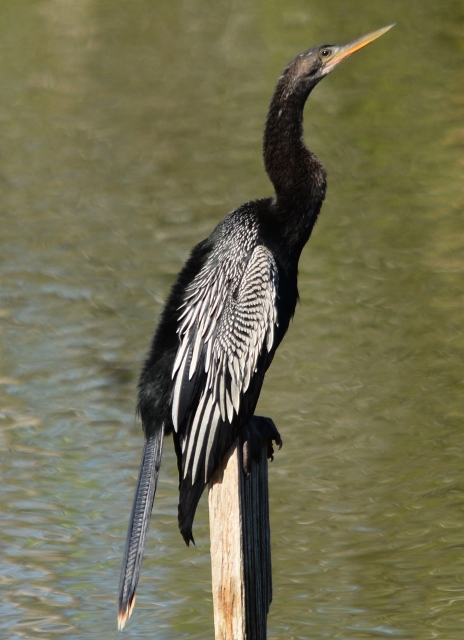
Cormorants have a curved, hooked bill — they grab their prey with their hooked bill.
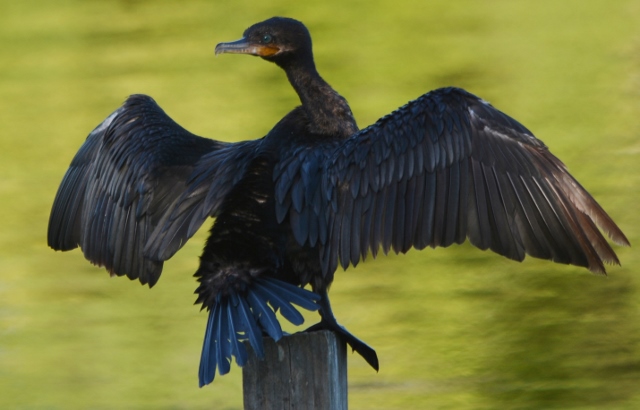
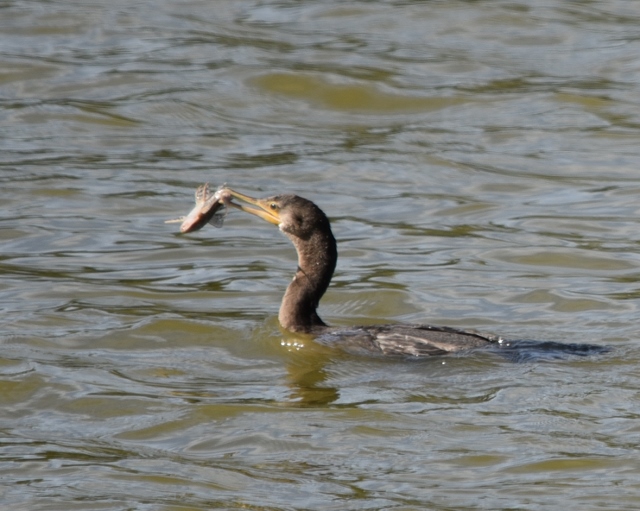
I should say that there are two species of cormorants here in our waters: the permanent resident neotropic cormorants whose northern most range is South Texas, and the winter visitors, the double-crested cormorants whose range goes to Canada, the southern Alaskan coast and equally north along the eastern shores of North America at the Atlantic Ocean.
To distinguish a neotropic from a double-crested, look again at the bill. The neotropic cormorant has a yellowish-brown throat skin below the eye. A double-crested cormorant has bright orange-yellow facial skin above, in front, and below the eye.
Both cormorants and anhinga feed primarily on fish; they hunt their prey by submerging in the water. They propel themselves with their wonderfully big, enviable-webbed feet — an asset that makes them fiendishly great swimmers when going after prey and a nice platform for balance when perched.
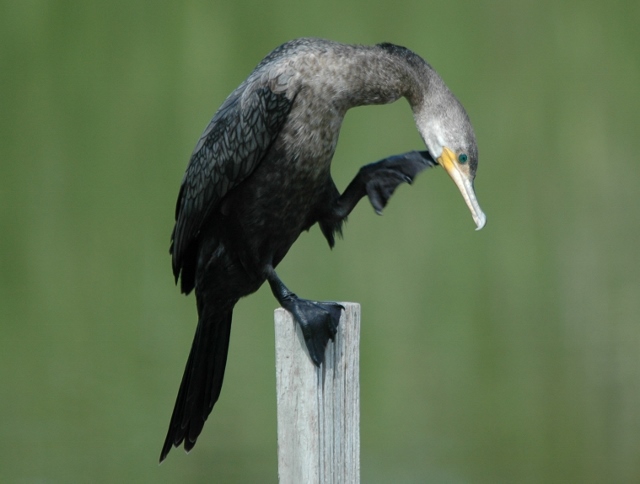
Neotropic cormorant’s feet are black as night; double-crested are described as blackish-gray; anhinga have yellowish-orange feet and legs.
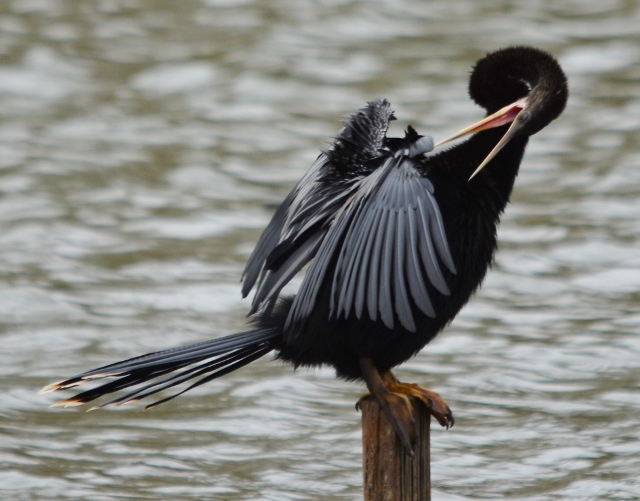
Most aquatic birds have natural oils on their feathers that help keep the birds dry and warm. The oils act like a life jacket, keeping the birds buoyant. Diving birds, like cormorants and anhingas, have lower oil levels on their feathers which reduces buoyancy and helps them submerge underwater.
Because their wings are not waterproof, anhingas and cormorants need to dry their wings; they perch in the sun and spread their wings in a majestic drape of beautiful feathers.
While both anhingas and cormorants have very dark brown to black feathers, the male anhinga has silvery to white streaks and spots on the upper back and forewings that are quite evident when the wings are spread.
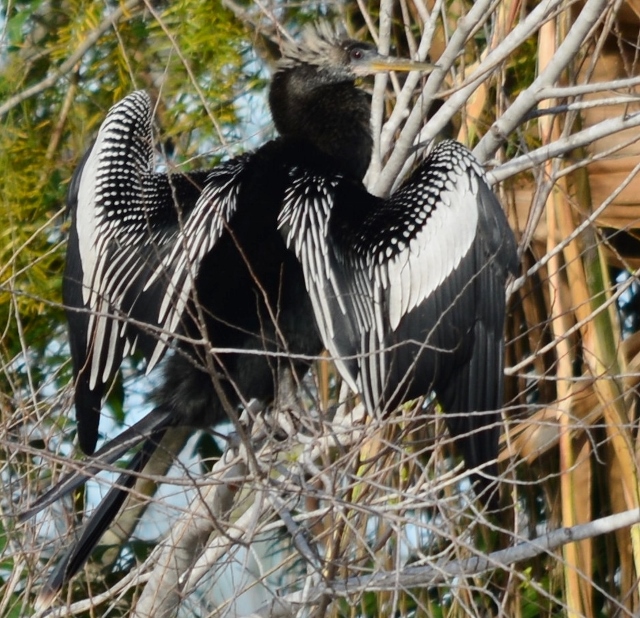
Female anhingas have a pale buff breast — as do juvenile neotropic cormorants; the juvenile neotropic is more mottled. The male anhinga has a black neck and head; the female has a golden brown neck and head
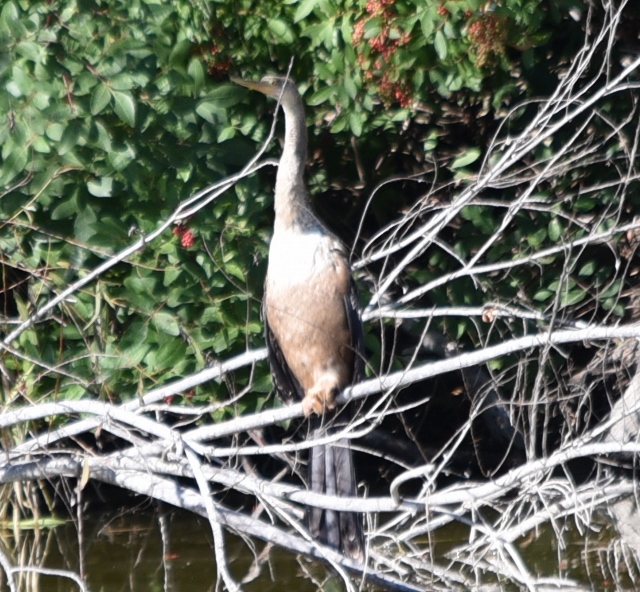
Cormorants have crystal-like turquoise colored eyes. Anhinga, dark to reddish eyes, depending on the bird’s age; males have a blue-green eye ring in their breeding plumage.
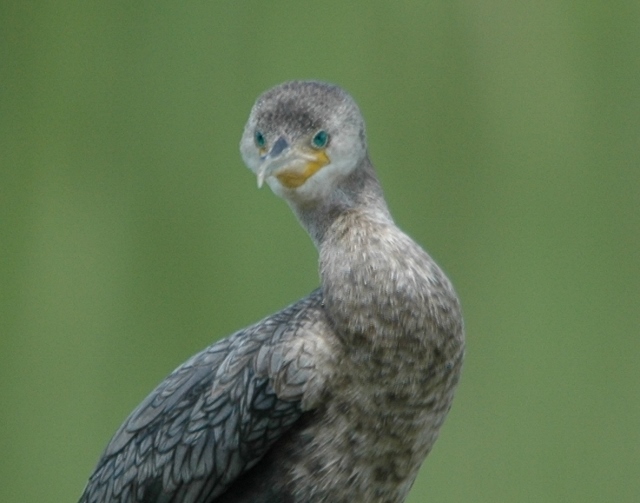
Anhinga are permanent residents at the very tip of Texas and all along the coast of the Gulf of Mexico, throughout Florida and coastal to the Carolinas.
The neotropic cormorant is smaller and longer-tailed than the double-crested cormorant. I might as well say, too, that you’ll not notice the double crest except during breeding season; the double-crested cormorant has two tufts of feathers on its head. The tufts are white on western birds and black on eastern birds. It gets complicated, doesn’t it?
According to allaboutbirds.org, the name anhinga comes from the Tupi Indians in Brazil, meaning devil bird or evil spirit of the woods. The name cormorant is kinder; it is a contraction of the Latin words, corvus and marinus, which taken together mean sea raven or sea crow.
Another great resaca fisher-bird is the osprey. The osprey will sit patiently on one of several favorite perches overlooking the resaca. In the blink of an eye, it jets off the perch, splashes the water and lifts off with a nice big fish, which it takes back to a perch for a lengthy feast.
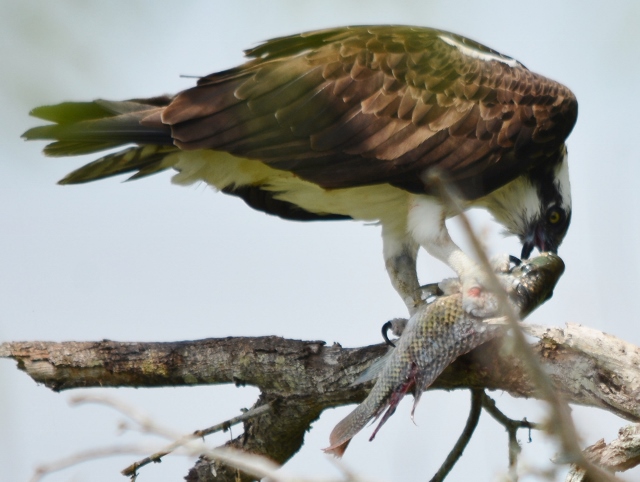
Interestingly, along with the usual fishing suspects, the herons, egrets, cormorants and osprey, a Great Kiskadee appeared to be trying its hand (or rather beak) at fishing the other day. It was on a snag at water level and eyeing the water like a great egret. Sure enough, kisdadees, too, are fishermen and will dive into the water to catch a fish or tadpole. Its alternate diet is a variety of crawling and flying insects. Ours are frequently seen hopping up from the ground and grabbing a white fruit from the Turk’s cap shrub.
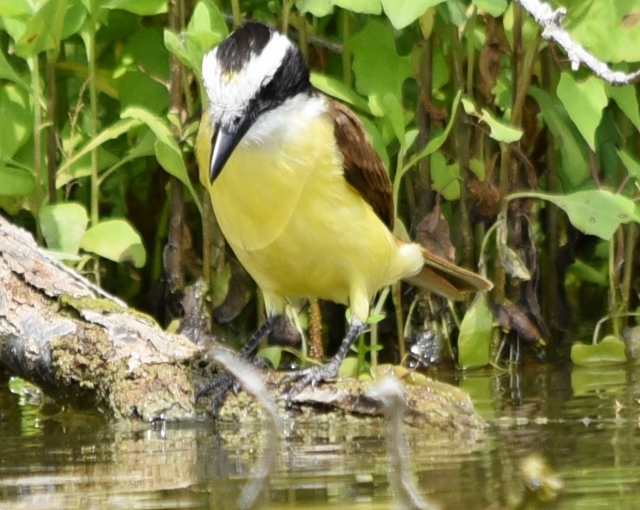
Not a fisher of fish, and an infrequent visitor perhaps just passing by for a rest and look-see this week were two white-tailed kites. They are a small hawk. When they dive, they most likely are after a prey on land, so I don’t know why these two were eyeing the resaca so closely. White-tailed kites hunt grasslands, savannas, roadsides and agricultural areas feasting on field mice, ground squirrels, shrews, small birds, small snakes, lizards, frogs, grasshoppers, crickets and beetles.
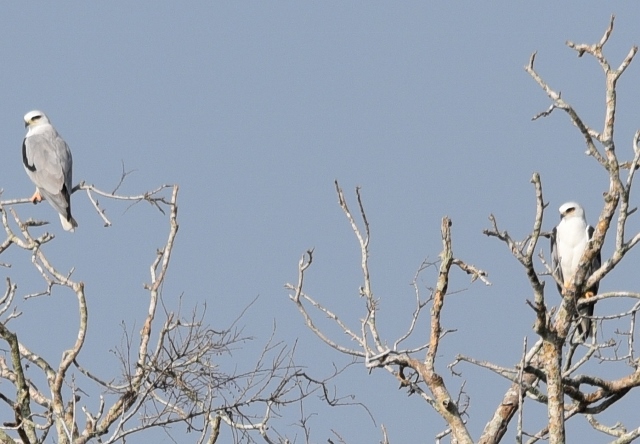
With all this resaca activity, it’s giving me good practice to look for details in order to join the annual Backyard Feeder Watcher portion of Audubon’s 121st annual Christmas Bird Count.
Backyard Feeder Watchers can help count birds without leaving home — a singular activity that by its very nature lends itself to a self-isolation endeavor. For Texas Master Naturalists who participate in the Backyard Feeder Watcher element of the Christmas Bird Count, time spent observing and counting birds and compiling and submitting tallies count toward Volunteer Time. It’s easy to do as an individual project. Contact a compiler from the below list of Rio Grande Valley count areas for instructions and a bird list.
Be sure to note that different areas have different compilers, different count dates and may have different deadlines for data collection.
Please contact the appropriate compiler prior to count day.
Coastal Tip of Texas — Thursday, December 16, 2020, Compiler Javier Gonzalez, 956-761-6801, naturalist@spibirding.com
Laguna Atascosa — Monday, December 28, 2020, Compilers Cathy Harrington and Mark Conway, markhconway@hotmail.com
Santa Ana — Saturday, December 19, 2020, Compiler Mary Beth Albrechtsen, 720-470-2960, SantaAnaCBC@gmail.com by Dec. 18
Anzalduas/Bentsen — Saturday, January 2, 2021, Compiler Roy Rodriguez, 956-584-9156, Roy.Rodriguez@tpwd.texas.gov
Harlingen — Saturday, January 2, 2021, Compiler Norma Friedrich, 361-676-6416, hgtxcbc@gmail.com
Falcon — Wednesday, December 30, Compiler Susan Foster, pfoster1@stx.rr.com
Kingsville — Saturday, January 2, 2021, Compiler Jim Sinclair, sinclairjim@yahoo.com